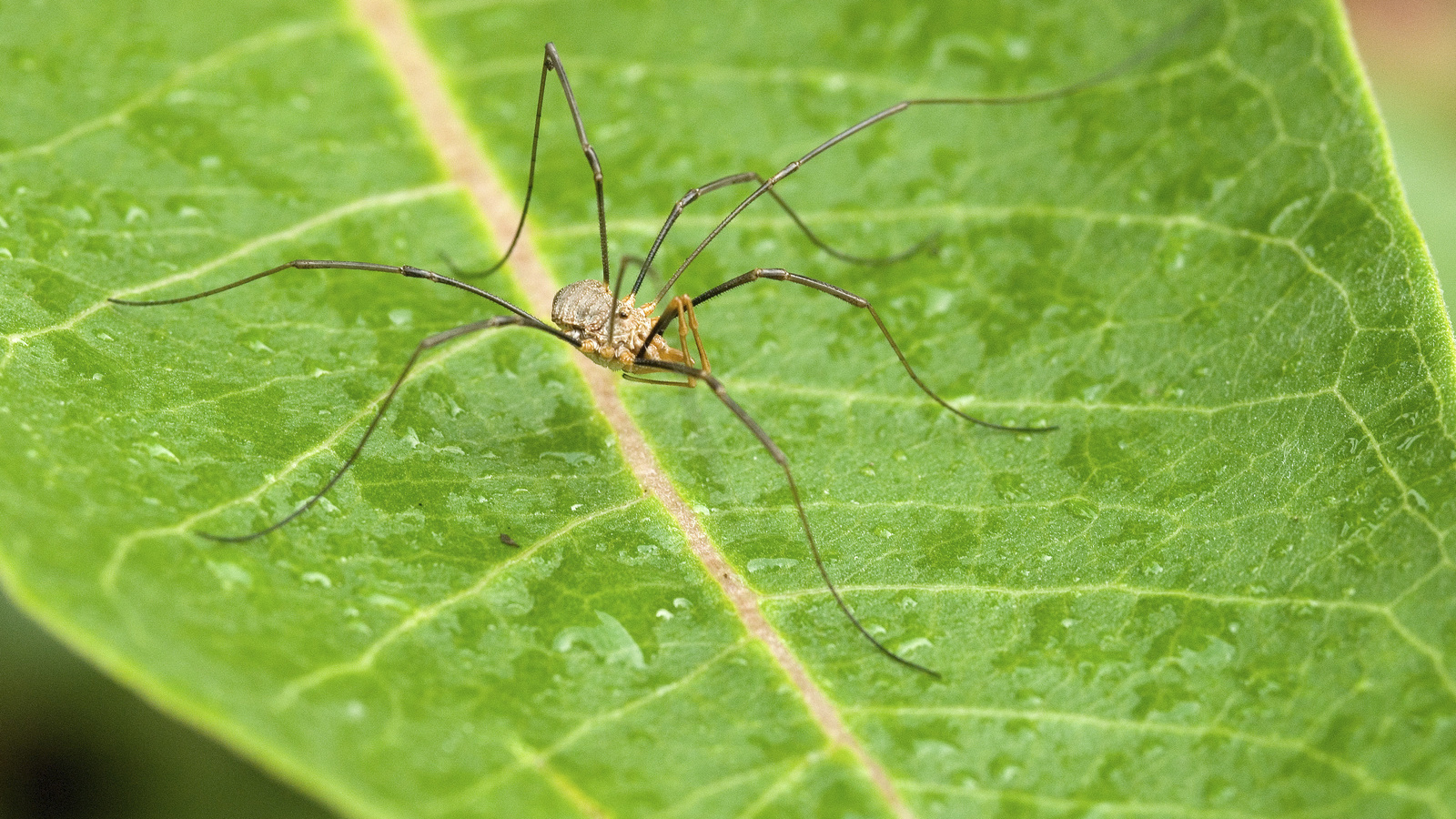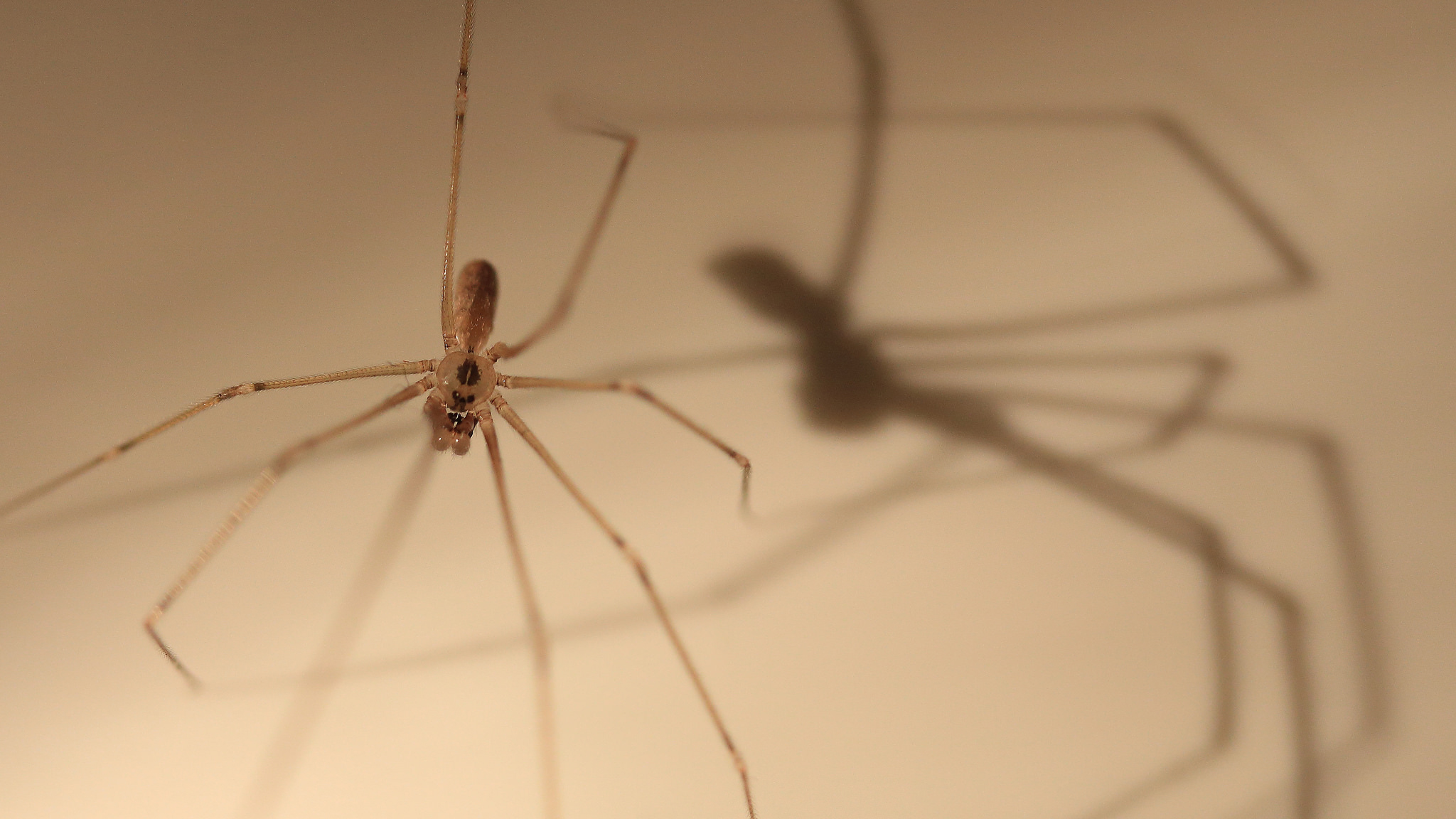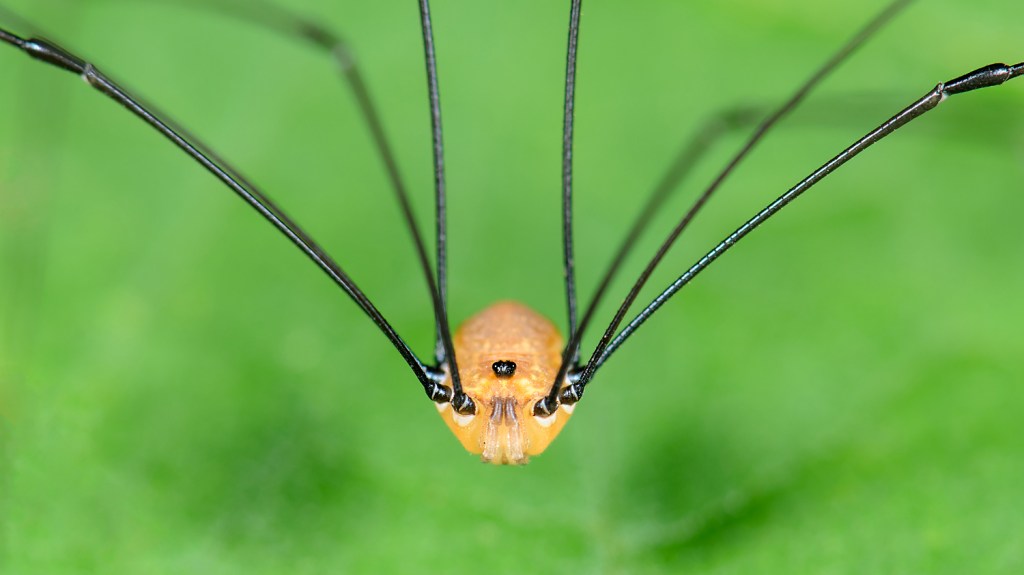I have been, for the better part of my life, terrified of spiders (and ticks and most arachnids). Not so daddy long-legs; when they happened to creep across my foot, I let it be. Then, one fateful day a friend told me that daddy longlegs are the most venomous spider on earth but they can’t bite people because their fangs are too short.
Could this be true? As an arachnophobic kid, I found it likely and spread the word. However, as an adult my skepticism kicked in and I decided to look into it. It turns out, I’m not the only one who has wondered about this. And it’s a slightly more complicated question than I thought.
There are two groups of arachnids to consider — the true daddy longlegs (of the order Opiliones) and the daddy longlegs spider (of the family Pholcidae).
Warning – if you are arachnophobic, you might want to skip the videos below.

Daddy Longlegs
A little background on daddy longlegs (also known as harvestmen) — they are not spiders, but they do belong to the class Arachnida along with spiders and many more eight-legged creatures. There are thousands of species of Opiliones around the world on every continent except Antarctica. Some incredibly well-preserved specimens in amber reveal that the Opiliones have remained largely unchanged for around 400 million years.
Unlike spiders they don’t have segmented bodies, they don’t spin webs, and no, they don’t have glands to produce venom or fangs to inject it. Some species of daddy longlegs do, however, secrete chemicals that could be poisonous to small predators – this is not a risk to humans.
In case you missed it, Opiliones recently went viral on the internet for their aggregation behavior. Up to 70,000 have been recorded gathering together in a mass that looks like a ball of hair. The reasons for this behavior are unknown – scientists hypothesize that it could have to do with maintaining humidity or avoiding predation.
Despite their namesake long legs, daddy longlegs don’t run around often. They spend most of their time sitting still in a crevice or under a log – they love shady, humid places, so you might find them in your basement or crawl space. Those legs don’t go to waste though; daddy longlegs can breathe through them. That’s right, their spiracles (breathing organs) are found on their fourth pair of legs.
Have you seen a daddy longlegs with a missing leg? They can lose them to avoid predation. In fact, the placement of the spiracles can cause the legs to continue twitching – distracting the would-be predator while the daddy longlegs escapes. However, once an adult loses its legs they don’t grow back.
Daddy longlegs truly are amazing. Far more intriguing than I anticipated when I thought that they were nature’s deadliest weapon, with the ever-present threat that they would evolve longer fangs (arachnophobia can give you weird ideas).

Quick Note on the Daddy Longlegs Spider
Though the daddy longlegs spider (Pholcidae) does have fangs and “venom” – note that not all venoms are dangerous to people – it has not been studied for its toxicity.
The team at MythBusters investigated whether the daddy longlegs spider might be the deadliest in the world and busted the myth on two counts. First, they got an expert to milk the venom and compare its effect on mice (a standard test for venoms) to the effect of the same amount of black widow venom. Black widows were far more deadly. Next, Adam Savage allowed himself to be bitten by a daddy longlegs spider – not only was it able to bite him, but he barely felt the bite and suffered no ill after effects.




That gave me a lot of information. THANK YOU!
My daughter was freaked out by a daddy long leg spider. (Thanks to me) but reading this helped her and myself! Thank you!
I think I have a “problem” with these spiders in my place in Florida because of a dampness situation. We are trying to remedy this. In the meantime, these spiders build webs in my bathroom and in my bedroom. I get rid of them, but I know that they are lurking for when I go back to New York, leave the house unattended, and then they go about their business. My question, (finally) is until we are able to fix the dampness situation which will take some major work, can I do anything to get rid of these spiders?
Hi, Lisa. I didn’t think Daddy Long Legs were spiders at all, but some sort of relative to the scorpion. They have an oval shaped body, no fangs, and mouthparts like a crab. They also do not seem to have the need to liquefy their food before eating it. Is this not correct? I’m a little confused.
Thanks!
Vicki
Got bit by a spider that look like a Cellar spider look like it had two legs in the front that look like antennas but they were legs chin chin swell up lots of blisters.
Not sure what kind of spider it was but one man said it look like a Cellar spider that that can bite but not much venom till I human but I’m very swollen had to go to the ER and this play another kind of spider
i’m really scared of spiders, especially these. i don’t know the deal with them. Why do they like to stay in human bedrooms and houses when they have the freedom to do their webs somewhere else outside?
Thanks for the comment! Sometimes our houses make good habitat for other things too, since daddy long legs (some Opiliones and all Pholcidae) like damp dark areas, I can see why they are attracted to places like basements. Our homes also provide a steady supply of water and sometimes food. Though I too wish they would stay outside, I can see why some wildlife are attracted to human habitation.
Growing up in the UK “Daddy Longlegs” was applied to Crane-flies (Tipulidae). Now in Canada, when someone tells me there’s a daddy longlegs, I have to ask which of three kinds! Most confusing.
Interesting! When I was writing this, I saw a few references to crane-flies as Daddy Longlegs (not as many as for the arachnids). I didn’t realize it was a UK nickname for them.
I was able to work at a summer camp in southern OH last summer and it was my first time seeing harvestmen, where I come from in NM the daddy long legs we have are the actual spiders. It was really cool learning about both of them and easing my fear of spiders bit by bit with my knowledge gained. This will really help when I teach the kids that not all spiders are scary and that the earth is there home too.
p.s. I’m actually thinking about studying these further in a scientific way, who knows what else we could learn!
Thank you Jami! I hope you do find a way to study them – it seems like we should know so much more about such a familiar creature.
Aw, the folk-lore is way more interesting. I have however been bitten by a field harvestman (caught in the act) in the soft skin at the back of the knee. created a lump not unlike a fleabite but now you mention it there wasn’t any secondary irritation that might be more normally expected with venom.
That is interesting, they do have mouths, so they could bite. No venom, so perhaps you are mildly allergic to their chemical secretions? Pure speculation on my part, but an interesting incident. Thank you!
I grew up summering at camp in Northeast, MD where daddy long legs “infested” the girls room. God help you if you had to pee at night. I had to shoo them away and they never bothered me so I always thought they were somewhat innocuous. Then, as an adult, I tried to gently move one out of my space and it bit me. It wasn’t life threatening, but a hard bite none the less. It hurt! Maybe it was the spider form but how can you tell?
I find the easiest way to tell is to look for the segmented body. The Opiliones have one large body segment and the Pholcidae have two segments (a head and an abdomen). It could have been either that bit you, as far as I know there is no scientific evidence that a harvestman can’t bite, only that they don’t have fangs or venom and so their bite would not be dangerous.
I enjoyed reading about this type of spider.
What do they eat and what eats them? Maybe more info on their life cycle. Thanks. My daughter is an entomologist . If I ask her she says I don’t know it all, google it.
This area is poorly studied. In my research I saw suggestions that they eat decaying plant matter and smaller insects (it may vary by species). I also read that it’s not really known known whether they hunt for insects or scavenge them. I didn’t find anything about what eats them – they do have chemicals to make them taste bad, so it might be a very limited list. Thank you for the question!
Nice little piece! I’ve also heard cellar spider for pholcids common name. That oblong abdomen is a dead give-away.
Minor correction for the sake of scientific literacy: Pholcidae is family level, not order.
Thank you Rea! You are right and I have corrected the post to reflect that Pholcidae is a family.
Strange synchronicity — my 11 year old daughter was repeating the daddy longlegs myth just last night, and I saw the blog this morning. Maybe she’ll sleep better after I show her the article… or not after seeing the hair ball video!
I think that’s about the age I was when I heard the story too. Thank you!
I’ve always liked daddy long legs and considered had one in house good luck. I moved and found 2. Then eggs and babies and had to put and end to it. There may still be one or two somewhere behind something.